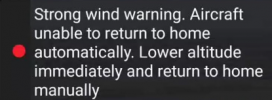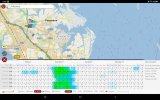then your drone will hover and do it's best to stay in position.
Assuming the
air 2 is similar to other DJI drones, whether or not that happens depends of the failsafe option setting. In most cases this will be RTH and such an
air 2 suffering a loss of connection will attempt to RTH.
It would only hover IF the failsafe option is set to hover, however even then it will only hover until the low battery RTH kicks in and then it will RTH. I tested this with a Mavic Mini and possibly an
M2P/Z.
@frcaloy just a point with regards to your comparison with the Cessna.
The Cessna's motor will, or perhaps should, run 'perfectly' happily until the fuel is exhausted. A DJI will not. Whilst there is still fuel/charge, but only a little, you may lose speed as the drone's software may limit power consumption to avoid damage to, perhaps, the battery. I forget the precise warning that is issued.
Beyond that point there is a charge percentage at which the software decides there is only enough charge to land the drone. At that point the drone will, if left to its own devices, start to land and make no further attempt to RTH.
This can, to some extent, be overridden by giving commands with the controller but speeds are SEVERELY limited and a lot of throttle must be given to keep the drone in the air. The drone will continue to fly in approximate accordance with the instructions issued by controller, or descend if the controller issues no commands, until the drone lands and do so until the battery is well below 0%.
Again there are you tubes etc. showing this and is some instances pilots, caught out over water etc. have saved their drone by commanding full (available) speed etc. and got their drone over land.
But, at a certain point the drones' software will decide that enough is enough and literally stop the motors even if the drone is still in mid air.












